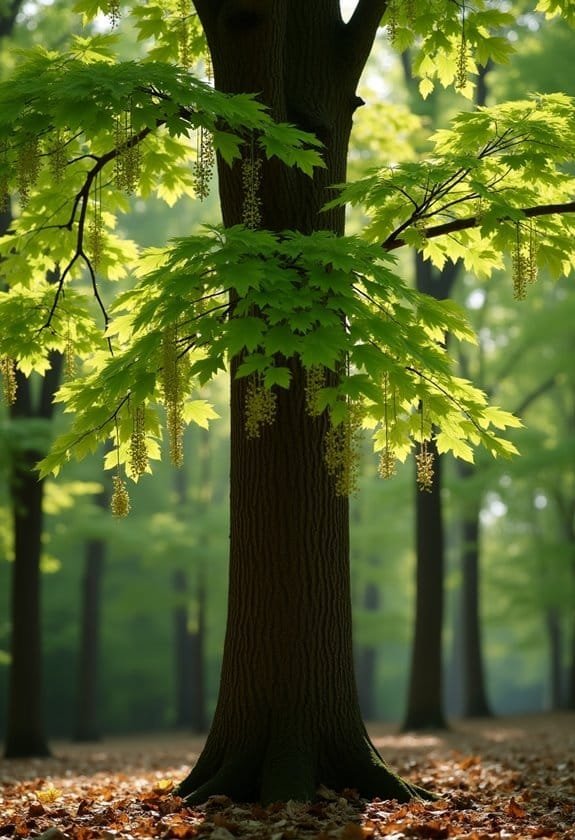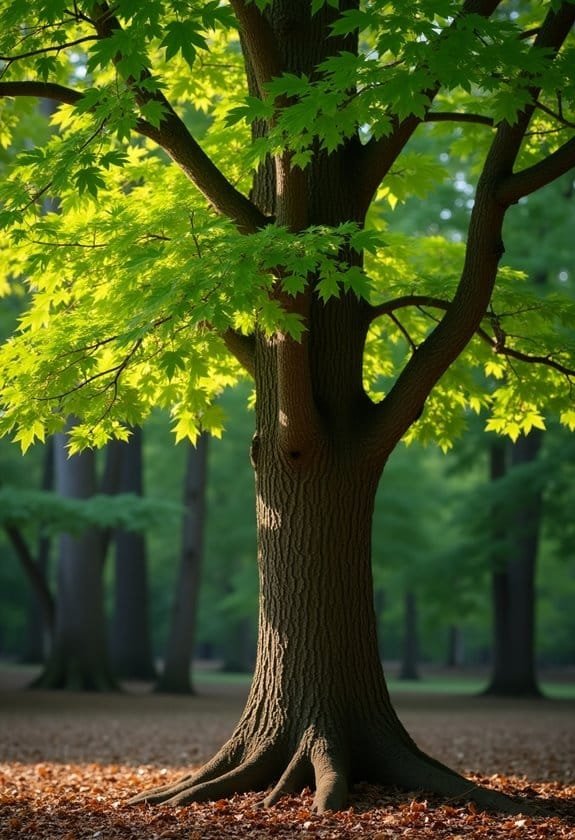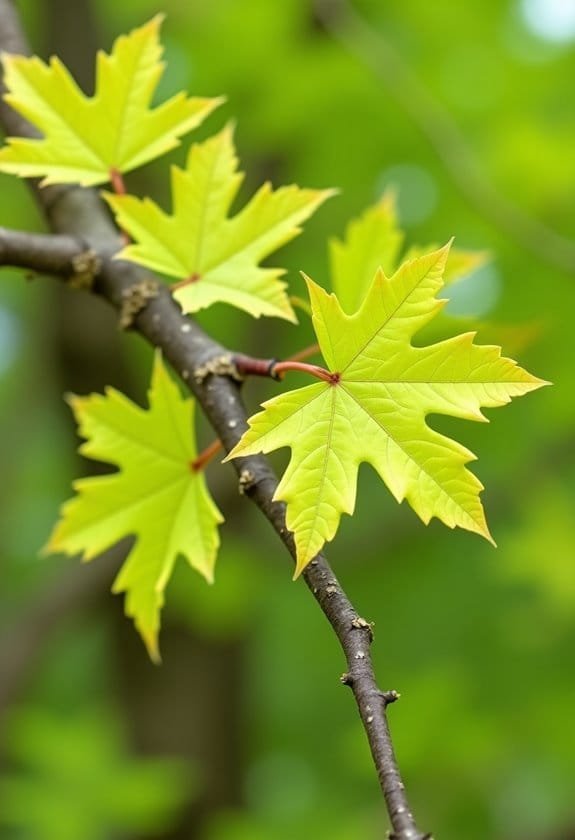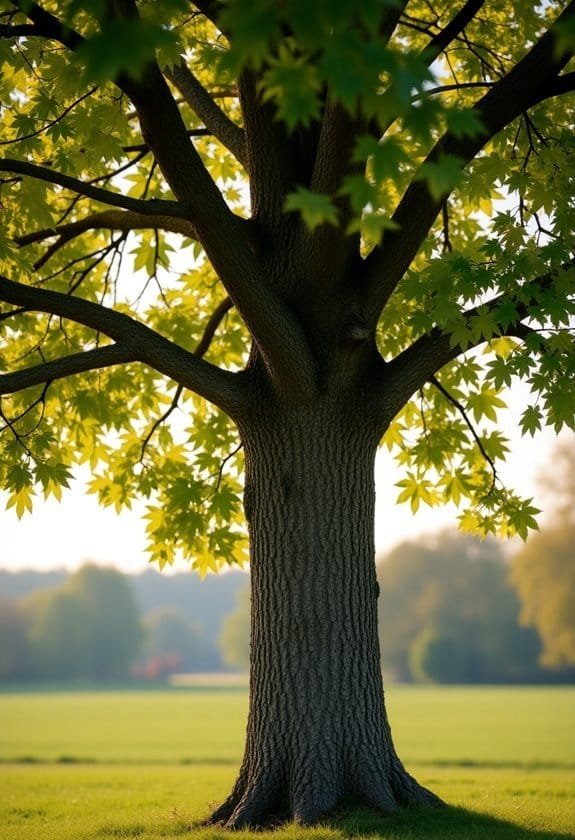Field Maple (Acer campestre) is a hardy deciduous tree reaching heights of 25-35 feet, characterized by its distinctive five-lobed leaves and horizontal-winged fruits called samaras. It's prized for its exceptional adaptability to various soil conditions and urban environments, thriving in USDA zones 4-7. The tree displays yellow-green spring flowers, dark green summer foliage, and vibrant yellow autumn colors, while its gray-black bark develops attractive ridges and furrows with age. As a valuable ecological resource, it supports local wildlife through pollination and nesting sites, making it an excellent choice for those seeking sustainable landscaping solutions.
Main Points
- Field Maple is a deciduous tree reaching 25-35 feet tall with distinctive five-lobed leaves and horizontally arranged winged fruits.
- Tolerant of various soil conditions and urban environments, making it ideal for landscaping and hedging in USDA zones 4-7.
- Features yellow-green spring flowers, dark green summer foliage, and vibrant yellow autumn colors, providing year-round aesthetic appeal.
- Supports local wildlife by providing nesting sites for birds and attracting pollinators like hoverflies to its spring blossoms.
- Requires well-drained soil, 4-6 hours of sunlight daily, and regular pruning in late winter for optimal growth and shape.
Introduction

The Field Maple (Acer campestre) stands as one of Europe's most adaptable native trees, combining modest size with remarkable resilience.
This deciduous species, which typically reaches heights of 25-35 feet, showcases distinctive five-lobed leaves and horizontally-arranged winged fruits known as samaras.
Its versatility in both urban and rural settings, coupled with its significant ecological value for wildlife and pollinators, has earned it widespread recognition in landscape design and environmental conservation.
Common Name
As one of Europe's most adaptable trees, Field Maple (Acer campestre) earned its common name from its prevalence in open fields and hedgerows. This versatile species has garnered several regional common names throughout its native range, with "Hedge Maple" being among the most widely recognized due to its exceptional ability to withstand regular pruning and form dense hedgerows.
The common name reflects both the tree's natural habitat and its historical usage in agricultural landscapes, where it has served as a living boundary marker for centuries. While "Field" emphasizes its tendency to grow along field margins and in open woodland edges, the designation "Maple" connects it to its larger botanical family, characterized by distinctive lobed leaves and winged fruits.
The tree's adaptability to various growing conditions has made it a familiar sight across European landscapes, where it thrives in both urban and rural settings. Its modest size, compared to other maple species, and its tolerance for different soil types have contributed to its widespread cultivation as an ornamental specimen, particularly in gardens where space might be limited.
Scientific Name
Field Maple's widespread common names connect to its scientific designation, Acer campestre, which provides a standardized way to identify this species across different regions and languages.
This binomial nomenclature, established within the taxonomic framework of the Sapindaceae family, reflects both the tree's generic classification and its natural habitat preferences.
The genus name "Acer," representing the broader maple tree group, combines with the specific epithet "campestre," which derives from Latin and translates to "of the fields," accurately describing where this species naturally occurs.
This scientific naming convention perfectly captures the field maple's tendency to thrive in various woodland environments, hedgerows, and open fields throughout Europe and western Asia.
The formal scientific designation helps distinguish this particular maple species, which can reach impressive heights of 15 to 25 meters and sustain life for up to 350 years, from its numerous relatives.
Its classification within the Sapindaceae family also connects it to other important hardwood trees, while its specific name provides valuable insights into its ecological preferences and natural distribution patterns.
Overview
Widespread throughout Europe and western Asia, Acer campestre stands as a remarkably adaptable deciduous tree that's earned its reputation as a versatile landscape feature.
The field maple's moderate size, reaching heights of 25-35 feet, makes it particularly suitable for urban environments where space might be limited.
This slow-growing species demonstrates impressive resilience, flourishing in various conditions that would challenge many other trees. Its ability to withstand soil compaction, air pollution, and dry spells has made it a favored choice for street plantings and recreational areas.
The tree's rounded mature habit, coupled with its palmately lobed leaves containing characteristic milky sap, creates an attractive silhouette in both urban and natural settings.
While the field maple's spring flowers may be inconspicuous, they play a crucial role in supporting local pollinators and wildlife populations.
The tree's horizontal-winged samaras later develop, potentially leading to prolific seed production.
Though its yellow autumn colors aren't consistently reliable, the species compensates with its year-round structural appeal and environmental adaptability, making it an essential addition to contemporary landscapes.
Key Features
The Field Maple stands as a moderately-sized deciduous tree, reaching heights of 25-35 feet at maturity with its characteristic rounded, dense crown.
Its palmately lobed leaves showcase 3-5 distinct segments with dark green coloration and produce a milky sap when damaged, while its yellow-green flowers emerge in spring, leading to distinctive horizontal-winged fruits.
These 5-centimeter samaras develop after flowering, creating a striking display against the tree's robust canopy and complementing its reliable yellow autumn colors.
Growth Size
Growing into a medium-sized deciduous tree, Acer campestre reaches heights of 25-35 feet with an equally broad spread, forming a dense, rounded crown at maturity. The field maple's growth pattern is characterized by its deliberate, steady pace, which contributes to its reputation as a slow-growing species among deciduous trees.
At full development, the trunk can achieve an impressive diameter of up to one meter (3 feet 3 inches), providing a sturdy foundation for its symmetrical canopy.
When maintained as a hedge, the tree demonstrates remarkable adaptability, though it requires regular pruning to maintain desired dimensions and shape. This versatility in growth form has earned it the alternative name "hedge maple" among horticulturists and gardeners.
The tree's adaptable nature extends to its growth requirements, as it flourishes in various soil conditions, particularly showing affinity for well-drained alkaline environments.
Its resilient growth characteristics make it particularly suitable for urban settings, where it maintains healthy development despite exposure to pollution and other environmental stressors commonly found in city environments.
Appearance
Distinguished by its compact, rounded silhouette, Field Maple presents several striking visual features that make it instantly recognizable. The tree's most prominent characteristic is its simple, palmately lobed leaves, which showcase a lustrous dark green surface and measure between three to five inches in length, typically displaying three to five distinct lobes.
The tree's architectural framework is enhanced by its distinctive bark, which exhibits a dark gray to gray-black coloration with subtle ridges and furrows creating an intricate textural pattern along its trunk and branches.
During spring, clusters of modest green flowers emerge throughout the canopy, eventually transforming into characteristic horizontal-winged samaras that add visual interest to the tree's profile.
As autumn approaches, the Field Maple undergoes a dramatic transformation, with its foliage shifting to vibrant yellow hues, creating a spectacular seasonal display.
This combination of year-round features – from its structured form and textured bark to its seasonal color changes – makes the Field Maple an aesthetically valuable specimen in both natural settings and cultivated landscapes.
Flowering Season
Spring's arrival heralds Field Maple's flowering season, with clusters of delicate yellow-green blooms emerging between April and May. These native maple flowers, while modest in appearance, play an essential role in the tree's reproductive cycle, forming inconspicuous clusters that measure 4-6 cm across.
The flowering process demonstrates remarkable ecological adaptation, as the blossoms appear before the leaves fully develop. This strategic timing guarantees ideal access for pollinating insects, particularly bees, which are drawn to the flowers' subtle offerings.
Each flower exhibits a fascinating hermaphroditic structure, containing both male and female reproductive components within its diminutive form.
The Field Maple's flowering strategy represents a sophisticated balance between self-pollination capabilities and insect-assisted reproduction. While the flowers can self-pollinate due to their hermaphroditic nature, they maintain features that attract insect pollinators, enhancing genetic diversity within the species.
Though these blossoms mightn't command attention like their showier counterparts in the landscape, their understated presence supports essential ecological processes throughout their spring blooming period.
Growing Requirements

Field maple proves remarkably adaptable in its growing requirements, flourishing in both full sun and partial shade while demonstrating impressive tolerance for various soil conditions.
The tree's resilience extends to its ability to thrive in rich, well-drained soils ranging from acidic to alkaline, making it particularly suited for urban landscapes where soil quality can vary considerably.
Though drought-resistant once established, young field maples benefit from consistent moisture and temperatures within USDA zones 4 to 7, where they can withstand both summer heat and winter frost with notable hardiness.
Light
When it comes to sunlight requirements, the Field Maple demonstrates remarkable adaptability by thriving in both full sun and partial shade conditions. This versatile tree needs a minimum of 4-6 hours of direct sunlight daily to maintain its characteristic light brown bark and achieve ideal growth patterns.
During its juvenile stages, the species particularly benefits from dappled shade, which helps protect its developing root system and foliage.
Once established, Field Maple exhibits impressive resilience in various light environments, though its most vigorous growth and densest canopy development occur in full-sun locations. The tree's ability to photosynthesize efficiently under different light intensities makes it an excellent choice for urban landscapes, where buildings and other structures may create varying degrees of shade throughout the day.
In these settings, the species demonstrates considerable tolerance to air pollution while maintaining healthy growth. The amount of sunlight exposure greatly influences the tree's autumn display, with specimens receiving full sun typically producing more vibrant fall colors and abundant seed production, ensuring the species' natural regeneration in suitable environments.
Soil
In terms of soil requirements, the hedge maple demonstrates remarkable versatility through its ability to thrive in various ground conditions. The species shows a distinct preference for rich, well-drained soil with pH levels ranging from alkaline to neutral, though it can successfully adapt to mildly acidic environments when necessary.
One of the field maple's most notable characteristics is its exceptional tolerance for challenging urban soil conditions, particularly in areas where compaction poses significant challenges for many other tree species.
This resilience, combined with its ability to withstand periods of drought, makes it an excellent choice for city planners and landscape architects seeking sustainable urban tree solutions.
The tree's capacity to flourish in compressed soils proves especially valuable in metropolitan settings, where construction and foot traffic frequently lead to dense ground conditions.
Additionally, its remarkable resistance to air pollution further enhances its suitability for urban environments, allowing it to maintain healthy growth even in areas with compromised air quality, where other species might struggle to establish themselves or maintain ideal health.
Water
Despite its adaptability to various conditions, ideal watering practices play an essential role in the field maple's development and long-term health. While mature specimens demonstrate remarkable resilience to dry soils and compaction, newly planted trees benefit from consistent moisture during their establishment phase.
Young field maples require regular watering schedules, particularly during extended dry periods, to develop robust root systems that will sustain them throughout their lifetime. Once established, these versatile trees showcase their drought-resistant nature, making them particularly well-suited for urban landscapes where water availability might be limited.
Their ability to withstand both moisture fluctuations and soil compaction underscores their reputation as low-maintenance specimens in various settings.
During prolonged drought conditions, even mature field maples benefit from occasional deep watering to maintain peak growth and vigor. However, their natural tolerance for dry conditions means they rarely require supplemental irrigation once established, making them an excellent choice for water-conscious landscaping projects where minimal intervention is desired.
This combination of initial care requirements and long-term resilience makes field maples particularly valuable in sustainable landscape design.
Temperature
The field maple's temperature tolerance makes it a reliable choice for temperate regions, particularly within USDA hardiness zones 4 to 7. Native to Europe, this adaptable species has evolved to withstand the varying temperatures typical of continental climates, demonstrating remarkable resilience throughout the seasons.
While the tree exhibits impressive cold hardiness, extreme winter conditions can pose challenges to its survival, particularly in zone 4 areas where temperatures drop considerably.
During the growing season, field maples thrive when temperatures allow for adequate sun exposure, ideally receiving 6 hours of direct sunlight daily. In warmer regions within its hardiness range, partial shade can protect the tree from heat stress, especially during its establishment phase.
The species' temperature adaptability contributes to its success in urban environments, where heat islands and fluctuating microclimates are common.
Like a well-designed thermostat, the field maple regulates its growth and dormancy cycles in response to seasonal temperature changes, making it a dependable choice for landscape architects seeking hardy, low-maintenance trees that can withstand temperature variations throughout the year.
Pollinator Criteria
Field Maple attracts a diverse array of pollinating insects through its small, green flowers that emerge in spring, offering crucial nectar and pollen resources.
The tree's role in supporting pollinators extends beyond its flowers, as its foliage serves as an essential host for numerous caterpillar species that later develop into adult butterflies and moths.
Its remarkable adaptability to urban environments makes Field Maple particularly valuable for maintaining pollinator populations in city landscapes, where natural habitats are often limited.
Attracted Pollinators
As a valuable resource for pollinators, Acer campestre attracts numerous beneficial insects with its small, greenish spring flowers that produce both nectar and pollen. The greenish yellow blooms serve as essential feeding stations for various bee species, while butterflies frequently visit these modest yet productive flowers during their peak flowering period.
The tree's ecological significance extends beyond its floral offerings, as its dense foliage creates a complex habitat network supporting multiple pollinator species.
Aphids and caterpillars feeding on the maple's leaves attract secondary pollinators like ladybirds and hoverflies, which contribute to the local ecosystem's pollination processes. The tree's robust crown structure provides vital nesting sites for birds, which play dual roles as both pollinators and seed dispersers.
The Field Maple's wind-dispersed samaras contribute to the establishment of new trees, creating additional pollinator habitats across the landscape. This reproductive strategy helps maintain sustainable pollinator populations by establishing new food sources and shelter sites, ultimately strengthening the entire ecological network through its multiple supporting roles in the environment.
Pollination Method
While displaying modest yellow-green blooms, Acer campestre relies primarily on insect pollination for successful reproduction through its hermaphrodite flowers. The tree's clustered blossoms, arranged in groups spanning 4-6 centimeters across, create accessible landing platforms for diverse pollinating insects seeking nectar and pollen rewards.
The field maple's pollination strategy demonstrates remarkable efficiency through its dual-purpose flowers, which contain both male and female reproductive structures. These cup-shaped blooms emerge during spring, offering essential resources to bees and other pollinating insects when many urban environments face pollinator scarcity.
The tree's resilience to air pollution further enhances its role as a significant habitat supporter in city landscapes.
Following successful pollination, the fertilized flowers develop into distinctive winged fruits known as samaras. This transformation represents the culmination of the pollination process, where wind later takes over the dispersal role.
The field maple's ability to maintain effective pollination mechanisms, even in challenging urban conditions, highlights its significance in supporting ecosystem continuity and biodiversity.
Care & Maintenance

Field Maple's successful cultivation starts with selecting a well-drained planting site that receives 4-6 hours of sunlight daily and ensuring proper soil preparation.
Regular maintenance includes strategic pruning to maintain the tree's shape, particularly in hedgerow settings where dense growth requires careful management to preserve both form and function.
This adaptable species thrives alongside companion plants like shade-tolerant shrubs and ground covers, while its drought resistance and tolerance for soil compaction make it an excellent choice for urban landscapes.
Planting Tips
Growing a healthy field maple requires attention to several key planting and maintenance factors. The soil's composition plays a vital role, as these trees thrive in well-draining conditions where roots can access both moisture and air without risk of compaction.
When selecting a planting location, gardeners should verify the site provides adequate sunlight exposure of 4-6 hours daily.
The planting process demands careful consideration of soil depth and spacing, allowing sufficient room for the tree's mature spread while maintaining good air circulation. Prepare a hole twice the width of the root ball and at the same depth, incorporating organic matter to enhance drainage and nutrient availability.
During the establishment phase, consistent watering becomes essential, particularly in areas experiencing prolonged dry spells.
For best results, consider the soil pH levels, as field maples adapt well to both acidic and alkaline conditions but prefer a balanced environment.
Position the tree where it won't face competition from larger specimens, and maintain a mulch ring to suppress weeds while retaining soil moisture.
Regular monitoring for early signs of pest infestations or disease will verify successful establishment.
Ongoing Care
Successful establishment of a field maple leads naturally to its long-term maintenance requirements. Also known as hedge maple, this versatile tree demands regular attention to maintain its characteristic rounded form and guarantee ideal health throughout its lifetime.
Pruning stands as the cornerstone of field maple maintenance, with late winter or early spring serving as the prime time to shape and control the tree's growth pattern.
While naturally drought-resistant, the tree benefits from consistent moisture management, particularly during extended dry periods when supplemental watering becomes crucial. A balanced fertilization program, implemented in early spring, provides the necessary nutrients for robust growth and vibrant foliage development.
Disease prevention and pest management require vigilant monitoring, especially for common threats like scale insects and verticillium wilt, which can compromise the tree's liveliness if left unchecked.
The application of a 2-3 inch layer of organic mulch around the tree's base, extending to the drip line while keeping it away from the trunk, creates ideal conditions for root development and helps maintain consistent soil moisture levels throughout the growing season.
Suggested Companions
The art of companion planting enhances both the aesthetic appeal and ecological value of field maple landscapes. This slow growing shrub creates ideal conditions for a diverse array of complementary plants, particularly those that thrive in well-drained soils and varying light conditions.
Understory companions like ferns and hostas flourish beneath the maple's protective canopy, while spring-flowering shrubs such as viburnums and spireas provide visual interest during the tree's modest blooming period. The addition of native wildflowers and groundcovers not only creates a layered aesthetic but also attracts essential pollinators, strengthening the ecosystem's biodiversity.
For structured landscapes, combining field maple with other maintenance-friendly plants proves particularly effective. Boxwoods and similar hedging specimens complement the maple's regular pruning schedule, creating cohesive garden designs.
In partially shaded areas, dogwoods and serviceberry trees make excellent companions, as they've adapted to thrive in the dappled light conditions that field maples naturally create, forming a harmonious multi-tiered planting scheme that mirrors natural woodland communities.
Can Wood Sage Coexist with Field Maple in the Same Habitat?
Wood sage and field maple can coexist in the same habitat, thriving in partial shade and well-drained soils. The adaptability of both species to similar conditions fosters biodiversity in woodland edges and hedgerows. For more details on its growth patterns, check reliable wood sage plant information to understand its compatibility further.
Common Issues
Field maple faces several significant threats from both pests and diseases, with scale insects, aphids, and maple worms being primary concerns that can compromise the tree's vigor.
Common diseases like anthracnose and verticillium wilt can cause leaf discoloration and branch dieback, requiring prompt intervention through proper pruning and fungicide applications when necessary.
Regular monitoring and maintaining good air circulation around the tree, combined with appropriate cultural practices such as proper watering and mulching, help minimize these issues while promoting the tree's natural defense mechanisms.
Pests/Diseases
Common pests and diseases can greatly affect Acer campestre's health and vigor. Scale insects and aphids pose significant threats by extracting crucial sap from the tree's tissues, which can lead to stunted growth and declining vitality.
These persistent pests often establish colonies on branches and leaves, weakening the tree's natural defense mechanisms over time.
The field maple faces additional challenges from destructive insects like maple worms and cankerworms, which can strip trees of their foliage during active feeding periods.
Several fungal and bacterial pathogens also threaten these maples, with anthracnose and bacterial leaf scorch causing substantial damage to the tree's photosynthetic capabilities through premature leaf drop and discoloration.
Verticillium wilt presents a particularly serious concern, as this soil-borne fungus infiltrates the tree's vascular system, potentially leading to widespread decline and branch dieback.
The presence of powdery mildew can further compromise the tree's health by forming a distinctive white coating on leaf surfaces, which interferes with essential photosynthetic processes and ultimately impacts the maple's overall growth potential.
Solutions
Effective management of field maple's health challenges requires a multi-faceted approach to prevention and treatment. Regular monitoring of the tree's corky bark and foliage enables early detection of common issues, such as scale insects and aphids, which can be controlled through targeted insecticidal applications and biological control methods.
For fungal diseases like anthracnose and powdery mildew, implementing proper cultural practices proves vital. These include maintaining adequate air circulation through strategic pruning, avoiding overhead irrigation, and removing infected plant debris from around the tree's base.
When verticillium wilt strikes, affected branches should be promptly removed with sterilized tools to prevent disease spread.
Environmental stress management plays a significant role in strengthening the tree's natural defenses. This involves selecting appropriate planting sites with well-drained soil, maintaining ideal soil moisture levels, and applying organic mulch to regulate root temperature and retain moisture.
Professional arborists recommend conducting soil tests annually to guarantee proper nutrient levels and pH balance, supplementing with targeted fertilizers when necessary to support the tree's vigor and disease resistance.
Summary

A versatile and hardy species, Acer campestre (Field Maple) grows as a medium-sized deciduous tree reaching heights of 25-35 feet with a rounded crown. This adaptable tree has proven its worth in both urban and natural settings, demonstrating remarkable tolerance for various environmental challenges, including air pollution and drought conditions.
The Field Maple's distinctive characteristics include its palmately lobed leaves, which contain a milky sap and transform into stunning yellow to golden hues during autumn. In spring, the tree produces modest green flowers that develop into wind-dispersed samaras, enabling efficient natural propagation throughout its environment.
While slow-growing, this species offers long-term benefits through its manageable size and reliable performance in diverse settings.
Modern cultivation has produced several notable varieties, including the variegated Carnival, the purple-leaved Royal Ruby, and the compact Metro Gold®. These cultivars have expanded the tree's applications in landscape design while maintaining the species' fundamental resilience.
The Field Maple's combination of environmental adaptability, aesthetic appeal, and cultural significance has secured its position as a valuable component of both urban and rural landscapes.


